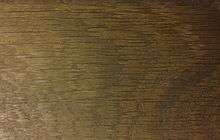Ammonia fuming

Ammonia fuming is a wood finishing process that darkens wood and brings out the grain pattern. It consists of exposing the wood to fumes from a strong aqueous solution of ammonium hydroxide which reacts with the tannins in the wood. The process works best on white oak because of the high tannin content of this wood. Fumed oak is also called smoked oak. Other species may also be fumed but usually will not darken as much as white oak. The introduction of the process is usually associated with the American furniture maker Gustav Stickley at the beginning of the twentieth century, but fuming was certainly known in Europe some time before this.
Process



The wood to be fumed is placed in a sealed chamber with all the surfaces to be fumed exposed to freely circulating air. A large shallow container of ammonium hydroxide solution is placed on the floor of the chamber and the chamber is sealed. If the chamber is large or the fuming is to be done for a long time then more than one container may be provided or the ammonia may be replenished during the process. The fuming time depends on the amount of darkening required, the size of the chamber, and the strength of the ammonia used. It is usual to oil the wood after fuming to fully bring out the effect.[1]
Advantages and disadvantages
Fuming has an advantage over staining in that it does not obscure the grain, it just darkens it. Unlike staining, there is no possibility of blotches or runs. Fuming is also colourfast. Fuming has the disadvantage that it is not a very precise process. Different batches of wood will react to fuming differently. For this reason wood that is to be fumed for a particular project is often taken from the same tree. Even so, boards from the same tree, and even different regions of the same board, can have a noticeably different colour. Where a consistent colour is important, staining or dyeing may be better options.[2]
Fuming has some inconvenient safety issues. The solution of ammonium hydroxide used is much stronger (26% to 30%) than in household ammonia and is corrosive. The fuming must be done in an enclosed sealed chamber. Ammonia splashes can burn skin and the fumes can cause burns to eyes and lungs.[3] Operators need to wear gas masks, gloves and eye protection.[4]
The darkening of the colour relies on the ammonia reacting with tannins in the wood. The process is most usually applied to white oak as this wood has a high tannin content. Red oak may turn greenish rather than deep brown. Other species may not darken so noticeably as white oak, or at all, depending on the tannin content. The effect of fuming can be enhanced in non-tannic woods by applying a coat of tannic acid to the surface before fuming.[5]
History
Fuming was an accidental discovery in England[6] after it was noticed that oak boards stored in a stable had darkened. This was caused by the ammonia fumes from the horse urine reacting with the wood.[7] At the end of the nineteenth and beginning of the twentieth centuries fuming became popular with furniture makers in the Arts and Crafts movement. The technique was introduced to the US by Gustav Stickley in 1901[8] and a manufacturing technique was perfected in the mission style furniture line of the Stickley family business.[9] Stickley also described a method of fuming the wooden architecture of an entire room by setting down bowls of ammonia within the room and completely sealing it. This method was not very practical and quite dangerous for the person placing the ammonia without the personal protective equipment available to modern workers.[10] Stickley was quickly followed by other American Arts and Crafts furniture makers such as Charles Limbert and the Roycroft community.[11]
References
Bibliography
- David M. Cathers, Gustav Stickley, Phaidon Press, 2003 ISBN 0714840300.
- Michael Clark, Jill Thomas-Clark, The Stickley Brothers, Gibbs Smith, 2002 ISBN 1586850539.
- Paul N. Hasluck, Manual of Traditional Wood Carving, Courier Dover Publications, 1977 ISBN 0486234894.
- Kevin Rodel, "Fuming with ammonia", in Finishes & Finishing Techniques, pages 56–60, Taunton Press, 1999 ISBN 1561582980.
- Bruce Smith, The Beautiful Necessity: Decorating with Arts and Crafts, Gibbs Smith, 2004 ISBN 1423609034.
- Gustav Stickley, The 1912 and 1915 Gustav Stickley Craftsman Furniture Catalogs, Courier Dover Publications, 2012 ISBN 0486138763.